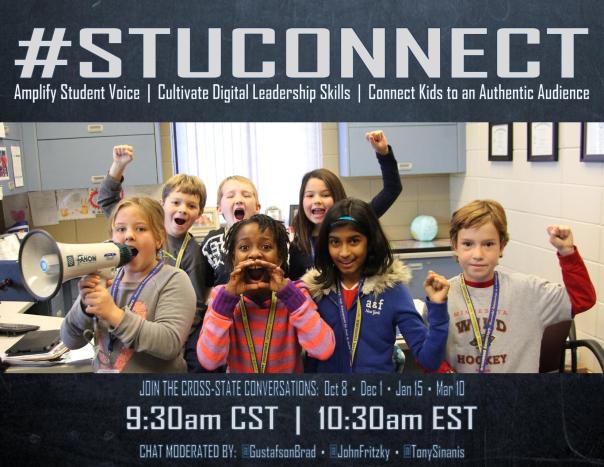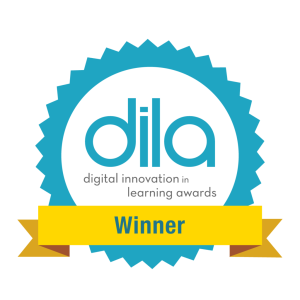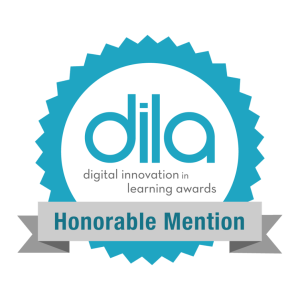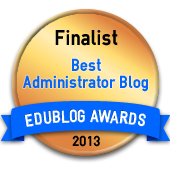Blog Archives
My Pastor was Right. Again.

So a funny thing happened a few years ago. I was sitting in church and our pastor at the time, Steve Wiens, started talking about neuroplasticity. I’ve always been a big nerd at heart, so I immediately took interest. Actually, I was totally eating the science up and loving every second of it. The truth of the matter is that Steve’s message helped me overcome some gunk in my life, and it’s a message I still carry with me when reflecting on change, innovation, and education.
In a nutshell, here’s what I gleaned from Steve’s sermon. We all have habits, tendencies, or even addictions that have become hard-wired into us. Some of these habits are good (holding the door for others, showering, and saying “thank you” are a few examples). Other habits are not so good. In fact, they can be downright destructive (fill in the blank with whatever unhealthy habit or failed New Year’s resolution you have here). If you’re an advanced learner or high-flyer you’re already connecting my sermon notes to education…but try to live in the moment and bear with me one more paragraph.
Our pastor likened these tendencies to footpaths formed in the snow. (I live in Minnesota mind you, so I hope you’re envisioning a lot of snow and very deep footpaths!) The more we travel a path, the easier it becomes to travel. Conversely, forging a new path can be extremely challenging. The first few times through the snow are always the toughest. In fact, it can be so difficult to take a new path that we might choose to revert down the same old path even when we recognize it is no longer the right direction in our lives.
Now on to the neuroscience of educational change. Creating new neurons involves linking something new to existing schema. (Remember, you can’t do this without a new path.) You’ve got to walk differently, practice, and persevere. So how might we link best practice to innovation in education? How do we connect the two in a manner that is “walkable” for others? What does that path even look like?
I believe that we’ve reached a point in education where we are collectively capable of giving kids more than they are currently receiving. All kids deserve innovative schools and I’m not okay with the fact that not all kids are experiencing this. There’s more work to do!
How do we get rid of some of the educational gunk (a.k.a. past tendencies, habits, etc.) and form some new dendrites? (See what I did there with the dendrites thing?!) I propose that we start by taking the first step. And then the next. Here are a couple examples so that this is not pure hyperbole:
- We know that students deserve redesigned learning spaces that support the 21st-century skills they’ll need…so we should take the first step in making it happen within our own sphere of influence (classroom, school, district, etc.)
- We know that we cannot be the experts of everything, and that connecting with other educators regardless of time/proximity only makes sense…so we should take the first step in helping a colleague on this path. We need to get more people connected so we can better serve our students.
Thinking different requires different steps. Different doing. And it is possible! My pastor was right.
_
Yes! This blog is moving to a new home. Hop over to www.BradGustafson.com to see how the Adjusting Course blog looks “all grown up.” I’d love your feedback on the new site too.
Where Ideas Go to Die
 Image Credit: Pixabay.com
Image Credit: Pixabay.com
Good idea. Bad idea. Things are not always black and white. Even the best ideas (or intentions) can lead to bad things if the culture of a school is not conducive to innovation.
It’s easy to say that we will do what’s best for kids, but more difficult to discern what is actually best when considering the potential impact on different stakeholders. Is research-based best practice the gold standard that we should never deviate from? Or is there room for new and untested ideas in education?
I tend to believe that kids deserve both, and so it pains me to know that there have been times that I’ve been a barrier to innovation. I know that I have made decisions that stifled progress. For example, this past school year one of our teachers approached me with an idea. He wanted to have our entire school (approximately 860 students) meet outside for an all-school photograph to commemorate our 50th anniversary…and he wanted the photo to be taken from a few hundred feet in the air.
I thought the idea of an aerial shot taken from one of our school’s drones sounded cool, but my visceral response was one of hesitancy. I tried to dissuade him because I thought that getting nearly 1,000 people (students and staff) outside at the same time would be too intrusive on teachers’ busy schedules. If I’m being completely honest, I probably also wanted to avoid undue criticism from anyone who was not super excited about the idea.
My perspective was skewed towards protecting the “routine” so we could keep moving forward. After all, what is best for kids is protecting the learning environment and their routine…right?!
Fortunately, the teacher who wanted to add this neat drone video perspective was pretty passionate about the idea. I quickly realized that a school’s 50th anniversary may actually be grounds for disrupting the routine. Long story short, we all met outside and it turned out to be some of the most amazing video footage I’ve ever seen. The best part is that our students are still raving about it.
 Image Credit: Twitter via @GWtechWPS
Image Credit: Twitter via @GWtechWPS
When I stare at the picture above it’s hard for me to distinguish their faces, but I do remember their reactions. They loved it. After watching the drone video they even started to think differently about things. I think we all did. This served as a reminder that there is an opportunity cost to what we say no to. Even if it is under the guise of “what’s best for kids.”
Most people do not wake up in the morning wanting to dash another person’s dreams…oftentimes we do it unknowingly. I pray that “What’s Best for Kids” is not where ideas go to die. I pray that I am not the person who kills them.
–
**Yes! The Adjusting Course blog is moving to a new home. Hop over to www.BradGustafson.com to subscribe to my new “ad free” blog. It will literally only take six seconds…unless your internet is slow…or you type slow…
I’ll keep cross-posting here for another month or so to give everyone a chance to switch over to the new site. (I’d love your feedback on the design too.)
Lunch & Tweet with the Commissioner

Join us for a “Lunch & Tweet” with Minnesota’s Commissioner of Education, Dr. Brenda Cassellius, on April 20th at 12:30pm CST.
Feel free to invite a colleague or fellow educator to participate. The questions we’ll be discussing are listed below. This is a great opportunity to dialogue with other educators who are committed to the success of Minnesota students.
Q1. What is working for Minnesota students? Share something great happening in your school. #MESPAmn
Q2. How are you helping all students and families connect and “belong” in your school? #MESPAmn
Q3. What is one thing you are learning, or hope to learn, to improve your leadership? #MESPAmn
Q4. What are some strategies your school is using to promote equity and close the achievement gap? #MESPAmn
Q5. Where do you see the greatest need in PreK education? #MESPAmn
Q6. Let’s talk pedagogy and innovation. How are you preparing students for their future? #MESPAmn
This Time it’s Personal

Yesterday a package arrived in the mail. It was from my aunt who sent me some old photographs of my dad…along with a heartfelt note. My dad passed away almost eight years ago without warning, so receiving the pictures was like an instant connection to him.
In the note my aunt mentioned that, “The memory of her brother (my dad) would forever live on in her heart,” and she thought I would appreciate having the pictures of him. She was right. I don’t have many pictures of my dad, so seeing him again yesterday was both beautiful and jarring. The package included pictures of my dad as a young boy, his wedding, my wedding, and more. I must have looked through the stack of pictures a dozen times yesterday.
I was chatting with my wife about the pictures as we were driving to get a sandwich for dinner. I asked her if we had any printed pictures of our family (and ourselves) to give our children one day. She responded in partial jest, “This is the digital world…we have passwords to digital pictures and video for our kids.” This got me thinking more about the digital world and the purpose of technology in schools.
As educators, we need to be really careful about the purpose we implore. We need to talk about pedagogy more often. (Not in short sound-bytes and 140 character bursts, but deeper dialogue.) I’m not naïve enough to think that my stated purpose for using technology should be your stated purpose. But we better be clear on our why each time we pass out paper and pencils, or digital devices. “Why” matters.
The transformative potential of technology does not rest solely in its ability to convert images and experiences to digital media. The power of technology is in how it can bring us together if we are intentional about it. Technology can support and amplify that which makes us uniquely human.
Through technology, our hurts and aspirations can become another person’s cause. The struggles that others share can activate our own empathy. Our ability to create, connect, reflect, wonder, imagine, innovate, express love, learn, share, and grow can be enhanced through technology.
If technology hinders any of these things we need to pause and reflect on the intended purpose. We’re hearing a lot about 1:1 initiatives as districts are striving to put a device in every student’s hand. I get why this can be a good thing, but I believe the ratio is wrong. The goal of any iPad or tablet initiative should be “1 to World” (or 1 to 7.4 billion people) because connecting kids to one another really does matter.
In addition to developing deeper connections and an understanding of others, technology can help us better connect to ourselves. I suppose this blog is a small example of reflection. Regardless, we need to better articulate the purpose and pedagogy for the technology we’re deploying. This brings me back to my dad.
There is nothing like holding a picture and touching the image of your dad. Every fold, fade, and discoloration of the paper can transport a person to a different time. There is a connection, for me, when I physically hold a photograph, book, or loved one. It is distinctly human. We need to be giving our kids this same perspective and opportunity when they are holding their devices.
Technology mustn’t replace connecting with others; the power of technology is its ability to extend and enhance how we connect to other human beings. How is your school leveraging technology as a tool that enhances relationships and learning? What is your why?

Are We There Yet?

Submarines are majestic vessels made to go deep. It’s what they do. Education can empower kids do the same if we reframe how we’re currently navigating things, but we’re not there yet.
I’ve been thinking a lot about pedagogy and the nature of learning lately. My thoughts have vacillated between two schools of thought. First, we need to ensure students master the vast number of state standards they are responsible for learning. In some ways, these standards are like mile markers, or buoys. The standards help us understand where students need to go.
I’m also in favor of reducing the number of standards so that we can facilitate deeper learning and discovery, and that brings me to my second point. We need to empower our students to innovate throughout their classroom careers. Students should have a voice in their learning, and we need to trust them to actually create some of the mile markers along the way.
This is a matter that is deeply personal to me. I want my own three children to have the tools and space to invent a future that none of us is fully capable of grasping. When they are navigating their educations alongside their grade-level classmates, I ultimately want them to be able to envision new markers in their journey. I desperately hope there is a space for that.
I believe kids can learn at a high level while being empowered to pursue their passions and curiosity. We cannot sacrifice curiosity for achievement; kids deserve both. (There really is no dichotomy.) I wonder if one of the greatest gifts we can give our kids is not taking away their curiosity.
Are we there yet? How will we know when we get there? What are the critical drivers that will propel us in the right direction? How do you think we can create the conditions where high levels of learning, innovation, and curiosity reside?
Buzzword or Lifeblood?

Image Credit: Jason Jenkins
I’ve heard some say that “student voice” is becoming a buzzword in education. I’m hopeful this is not true. We can’t let it be true.
Student voice should be the lifeblood of our schools. Our kids’ needs, aspirations, and voices should be predominant in education; from the boardroom to the classroom. (The same should be true of professional development!)
EdCampEC will be cranking up the volume and amplifying student voice on April 9th. Greenwood Elementary (MN) students will be teaching teachers through a hands-on and student-led MakerSpace challenge.
Recently, some of our 3rd graders participated in a BattleDome experience using 3D printed exo-skeletons. The exo-skeletons fit around Sphero robotic droids that teams navigated during the competition. Engineering and collaboration were interwoven throughout the experience, as students added different offensive and defensive capabilities to their exo-skeletons. Kids were “making” with a purpose and the entire experience was nothing short of spectacular.
You can read more about the experience HERE…OR you can make the trek to Eau Claire, Wisconsin on April 9th to hear directly from the students involved! They can tell you about their design process, and how different tools from our school’s Mobile MakerSpace fleet were used to unleash creativity and learning.
Student voice is alive and well! We couldn’t be prouder of our kids, and we look forward to seeing their leadership and communication skills shine at EdCampEC.
If you have questions before April 9th (or can’t make the trip) don’t hesitate to reach out to the teachers who organized the Sphero-Exo event.
The Dark Part of Black History Month

If you really want to know if you are a culturally sensitive leader just ask your students about Black History Month.
Students often associate February with Valentine’s Day, I Love to Read Month, or even the 100th day of school. These are really comfortable things to talk about. What I’m less inclined to talk about is how the color of a person’s skin may impact the opportunities that person experiences. I’m even less excited to reflect upon my own white privilege.
These are some of the hardest conversations I’ve never had.
And I’m done not having them. Fortunately I work with an amazing team of teachers who are helping me with my journey. They push me. They help us get better for all kids…not just the kids who may look like us.
This school year I’ve been reading a different book each month to individual classrooms. This month…Black History Month…I’m reading, “All Different Now” by Angela Johnson. I’ve had the chance to fumble through some pretty powerful conversations with students. Admittedly, my contributions have been limited to asking a few difficult questions and then listening to students. I’m seeking to understand. At the same time I’m digging deeper.
What I’m learning is that I have a long way to go. Our kids are counting on me, and us, to teach them how to be culturally sensitive. How can I do that if I’m not part of the conversation?
The silence is blaring.
I need to confront my own comfort with the status quo. I need to question why I might be feeling so comfortable while others around me are hurting, angry, and oppressed. I need to acknowledge that my own truth is not always the same truth and journey that others have experienced.
Recently, I had the chance to connect with Brandi Bates about this topic on a radio program called, UnearthED. You can click HERE to listen to our 10 minute conversation.
Brandi helped me begin to shine the light on the dark part of Black History Month; my own white privilege.


Subscribe to “UnearthED” in iTunes for more conversations that matter to the kids we serve.
unearthED
If you had ten minutes to talk about anything you wanted to what would it be? What if you could join a conversation that educators halfway across the country were having about the very same topic?
I’m co-hosting a new show on the BAM Radio Network called, unearthED. The show premiered in iTunes this week and was listed on the “new and noteworthy” list. We’ll be following the energy behind different conversations that teachers and school leaders are having on social media, and then taking them deeper.
We think students deserve a new narrative because many of the conversations on Twitter are too important to skim over. My good friend and co-host, Ben Gilpin, and I are committed to delving further into the issues that every educator confronts. The show is less about answers and more about questions, vulnerability, and authenticity.
Our show is part of the BAM Radio Network’s TweetED Channel covering the best Twitter education chats of the week. We hope you’ll listen and subscribe, but most of all we hope you will join us in moving beyond the echo chamber. We think kids will benefit when we continue these conversations together.
You can subscribe to “unearthED” by clicking HERE or copying the link below into your browser.

https://itunes.apple.com/us/podcast/unearthed/id1073709918
StuConnect Classroom Twitter Chat

Join classrooms across the country as we celebrate student passion on December 1st at 9:30am CST. Click HERE to watch a short (3 minute) podcast prepared by students in two different states. Then join the conversation this Tuesday by tagging your classroom Tweets with the hashtag #StuConnect.
The entire chat will only last 20-30 minutes. Feel free to join us for one question or stick around for the entire chat. All grade-levels are welcome to participate. We will share out a new question every 6-7 minutes. Classrooms can respond to specific questions by starting their Tweets with the letter “A” (stands for Answer) and adding the hashtag #StuConnect to the very end of each Tweet.
A preview of the questions is below:
- Introduce your classroom or school and share what state you are from. #StuConnect
- Q1 What are your passions and talents? #StuConnect
- Q2 Why is knowing what you are talented at important? #StuConnect
- Q3 How do you get to ‘practice your passion’ in school? #StuConnect
- Q4 Where else do you get to spend time in an area interest? How might school help with this? #StuConnect
Special thanks to my #StuConnect co-moderators John Fritzky (NJ) and Tony Sinanis (NY) as well as one of our fabulous student-teachers, Ms. Frick, for helping produce the podcast. We hope you can join us for the Twitter chat at 9:30am CST on Tuesday, December 1st, 2015!
Perspective

Image Credit: http://www.themarketworld.com
What do you notice about this picture? It doesn’t really bother me that the people are moving in different directions. In fact, I think moving in the same direction without questioning our purpose could be dangerous. In some ways this is analogous to education.
Education is filled with some of the most dedicated and selfless individuals on the planet. These people are trying to make a difference for kids in the best way they know how. Some strive to integrate technology while others question its utility. Neither approach is inherently wrong, but there has to be a purpose and pedagogy behind our teaching that is just as important as the teaching itself.
Before we dip our oars in the water we should be able to identify two things:
- Purpose: Why is the direction, idea, or path we’re pursuing important to our students?
- Pedagogy: How might the approach we take be more relevant to the lives of our students?
All students deserve the opportunity to experience a relevant and connected pedagogy that leverages the promises of the digital age. This does not mean that every learning experience needs to involve a device or Wi-Fi. It does mean that the context in which we are teaching has changed dramatically and the pedagogy we implore must be responsive to these changes. Creativity and collaboration are not soft skills that can be sacrificed in the pursuit of student achievement. The pedagogy we implore must prioritize digital age skills and tools while helping all students learn at a high level.
Perhaps a new direction is warranted. What’s your perspective?

















